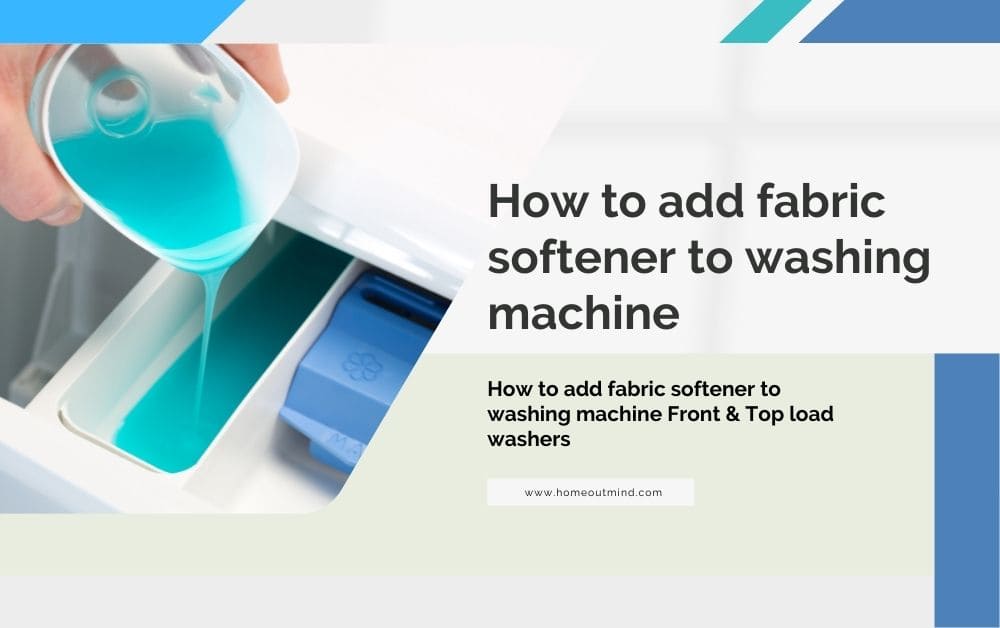Towels like sandpaper? Clothes a static show? I’m here to help! As a laundry pro, fabric softener isn’t just fluff – it’s a science for softer, static-free clothes, even a touch of fragrance.
This guide, whether you’re a laundry veteran or a washday newbie, will help you harness this magic formula for any machine. Let’s unlock smoother, happier laundry – together!

Choosing the Right Fabric Softener
Now that you’re ready to embrace the power of softness, let’s pick the perfect partner for your laundry needs!
1. The Squad:
Choose your weapon wisely. We have three main contenders:
Liquid Champions: The OG softeners, offering precise dosage and often packed with additional conditioning benefits.
Dryer Sheet Warriors: Convenient and portable, perfect for a quick touch-up, but consider their limited impact on towels.
Scent Bead Brigades: Tiny powerhouses bursting with fragrance, but some machines (and noses) prefer them less.
2. Fabric Intel:
Not all heroes wear capes (or towels); it’s vital to match your softener to your fabric squad.
Delicate Darlings: Opt for gentle, fragrance-free formulas to avoid irritation. Silk and wool often prefer a vinegar rinse over traditional softeners.
Towel Titans: Prioritize absorbency over excessive softness. Look for softeners specially formulated for towels to avoid hindering their drying power.
Active All-Stars: Opt for formulas designed for workout wear to combat sweat odors and wicking issues.
3. Allergy Awareness:
Listen to your skin, friends! If you have sensitive skin or allergies, opt for fragrance-free and hypoallergenic softeners. Consider natural alternatives like wool dryer balls for a gentle touch.
Remember, choosing the right fabric softener is about more than just scent. Match it to your fabric needs and listen to your skin’s preferences for the ultimate laundry victory!
Adding Fabric Softener to Your Washing Machine: Step-by-Step Guide
Step 1: Finding Your Softener Spot:
Look for a special compartment in your washing machine. It might be labeled “fabric softener” or “conditioner.”
Top-loaders usually have it in the center, while front-loaders hide it in a drawer, often on the bottom left or right. Check your machine’s manual if you’re unsure.
Step 2: Choosing the Right Friend for Your Fabrics:
Liquid Champions: Great for precise amounts and extra care.
Dryer Sheet Warriors: Quick and convenient, but not as strong for towels.
Scent Bead Brigades: Add fragrance, but some machines (and noses) aren’t fans.
Remember, it’s not just about scent! Pick the softener that suits your fabric needs:
Delicate Darlings: Use gentle, unscented softeners to avoid irritation. Wool and silk prefer a vinegar rinse instead.
Towel Titans: Focus on absorbency, not just softness. Look for softeners made for towels so they still dry well.
Active All-Stars: Choose formulas designed for workout clothes to fight sweat and keep them breathable.
Step 3: The Art of Not Overdoing It:
Imagine cooking: too much spice ruins the dish! The same goes for fabric softener. Using too much makes clothes feel stiff or greasy. Here’s how to avoid that fashion fumble:
Read the Label: It’s your laundry guide! Follow the instructions for the amount based on your load size and machine type. Remember, less is often more.
Strong Stuff Needs Less: Concentrated softeners are powerful, so you’ll need even less. If unsure, dilute it a bit. Water hardness and your preferences can also affect the perfect amount.
Step 4: Softening Magic at the Right Time:
Think of fabric softener as the finishing touch, not the main course. Here’s the secret:
After the Sudsy Work is Done: Unlike detergent, fabric softener works best during the final rinse cycle, not the main wash. Adding it earlier weakens its effect, like adding dessert spices at the start of cooking.
Machines With Built-in Helpers: Some machines have dispensers like your laundry assistants. Just fill them as instructed and let them take care of the rest.
Manual Masters: No automatic dispenser? No worries! Be the conductor of your laundry orchestra. Add the softener just before the final rinse starts, watching your machine for clues or checking the manual for timing.
Step 5: Keeping the Softener Happy:
Your job doesn’t end there, brave laundry warrior! To keep your machine and clothes happy, consider using a cleaning solution designed for the dispenser (check your manual).
Doing this once a month keeps the softener flowing freely and your clothes luxuriously soft.
Conquer these steps, understand your machine, and use the right amount of softener. Once a mystery, fabric softener will become your secret weapon for soft, comfortable clothes. Go forth and embrace the feeling of softness, free from stiffness and static!
Pro Tips and Troubleshooting:
Softener Stains Got You Down?
Dilute the Power: Before adding softener, mix it with water like a mini science experiment! This tames its strength and prevents those pesky stains. Remember, a little goes a long way!
Be Careful with Delicates: Treat delicate clothes like royalty! Avoid pouring softener directly on them, as it can leave stubborn marks. Stick to adding it to the dispenser.
Keeping Your Dispenser Happy:
Cleanliness is Key: Just like you take care of yourself, take care of your machine’s dispenser! A quick monthly wipe-down with warm water and mild detergent keeps things running smoothly.
Sensitive Skin Solutions:
Vinegar’s Magic Touch: Worried about skin reactions? Vinegar to the rescue! A vinegar rinse during the final cycle naturally softens fabrics and is gentle on even the most sensitive skin. Plus, it’s eco-friendly and readily available!
Dryer Ball Power: These eco-warriors are allergy-friendly and amazing! They reduce static cling, fluff up clothes without chemicals, and last for years!
Bonus Tip: Want a natural scent? Skip the chemicals and explore essential oils! Add a few drops to a wool dryer ball or dilute them in water before the rinse cycle. Lavender relaxes, while citrus gives a fresh burst!
More Laundry Wisdom:
Towel Troubles: Feeling stiff towels? Try a softener made for towels! They prioritize absorbency without sacrificing softness. Don’t overload your machine either, as towels need space to rinse properly.
Hard Water Blues: Hard water can weaken softener. If you suspect this, consider adding a laundry-specific water softener following the instructions.
Scent Sensitivity: Opt for fragrance-free softeners, vinegar, or dryer balls if strong scents bother you. You can also use essential oils on dryer balls for a personal touch.
Laundry doesn’t have to be a struggle! With these simple tips, you’ll be a fabric softener master in no time, enjoying soft, static-free clothes every wash. Go forth, conquer laundry day, and embrace the comfort!
Do I really need fabric softener?
While not strictly necessary, fabric softener offers several benefits beyond simply making clothes feel soft. Here’s the lowdown:
Softness and Comfort: It reduces fabric stiffness and roughness, making clothes feel more comfortable and pleasant against the skin.
Static Cling Control: Say goodbye to those annoying shocks and clingy clothes sticking to everything. Fabric softener helps dissipate static electricity, especially useful in dry winter months.
Increased Absorbency (Towels): For towels, specific formulas enhance water absorption, making them fluffier and more effective at drying you off.
Easier Ironing: Softer fabrics relax wrinkles, making ironing quicker and easier.
Fresher Scents (Optional): Some softeners come with pleasant fragrances, adding a touch of freshness to your laundry.
Which type of fabric softener should I use?
The best choice depends on your needs and laundry setup:
Liquid Softeners: Most popular, offering precise dosage and often containing conditioning benefits.
Dryer Sheets: Convenient and portable, but less effective for towels and may leave residue on some fabrics.
Scent Beads: Burst with fragrance, but some machines (and noses) prefer them less and they offer limited other benefits.
When should I add fabric softener?
Always add fabric softener during the final rinse cycle, not the main wash. This ensures it doesn’t interfere with detergent’s cleaning action and gets distributed evenly on clothes.
Modern machines: Often have built-in dispensers. Fill them according to the manufacturer’s instructions and let them handle the dispensing.
Machines without dispensers: Add the softener just before the final rinse cycle begins, following the product’s instructions and your machine’s timing cues (consult the manual if needed).
Are fabric softeners safe for sensitive skin?
Some people with sensitive skin might experience irritation from certain fabric softeners, especially those with strong fragrances or dyes.
- Opt for fragrance-free and hypoallergenic formulas.
- Consider natural alternatives like vinegar or wool dryer balls, which are gentler on skin.
- Perform a patch test on a small, inconspicuous area of clothing before using a new softener on your entire load.
Can fabric softener damage my washing machine?
No, using fabric softener correctly shouldn’t damage your washing machine. However, improper use can lead to build-up in the dispenser and other parts, potentially affecting performance.
- Always follow the dosage instructions for both the softener and your machine.
- Clean the dispenser regularly according to your machine’s manual.
- Avoid using excessive amounts of softener.
What happens when you mix up detergent and fabric softener?
Mixing up detergent and fabric softener isn’t ideal, but it usually won’t cause major harm. Here’s what you can expect:
In the wash cycle:
Reduced effectiveness: Both products interact, potentially reducing the cleaning power of your detergent and the softening benefits of the softener.
Potential foaming: Combining them might create excessive suds, which can hinder rinsing and leave residue on clothes.
No major damage: Generally, mixing them won’t harm your clothes or washing machine.
After the wash:
Stiffness or residue: Residue from both products could leave clothes feeling stiff or slightly greasy.
Reduced absorbency: This is especially true for towels, as softener residue can affect their ability to absorb water.
No color changes: Mixing them shouldn’t cause discoloration to your clothes.
What to do if you mixed them up:
- Don’t panic! It’s a common mistake and usually not serious.
- Run an extra rinse cycle: This helps remove any residue and improve rinsing.
- Use less softener in the next wash: If the clothes feel stiff, avoid adding softener in the next cycle.
- Clean your dispenser: Over time, residue can build up, so cleaning the dispenser regularly is recommended anyway.
Conclusion
Bid farewell to scratchy towels and static zaps! Mastering fabric softener isn’t just about fluff, it’s about a laundry transformation.
Dive into luxuriously soft clothes, free from cling and (optionally) infused with your favorite scent. Bonus: softer fabrics iron smoother, saving time! Ready to join the soft-clothed revolution?
Grab your softener, unleash your laundry warrior spirit, and share your triumphs in the comments below! Let’s make laundry day something to celebrate!






